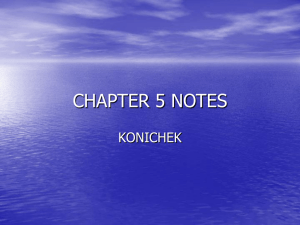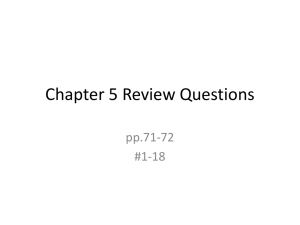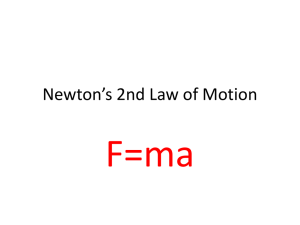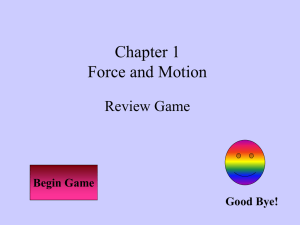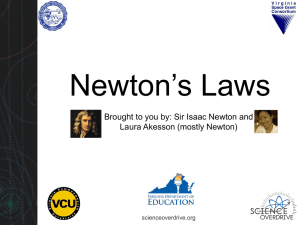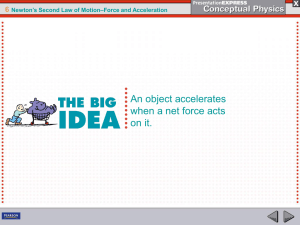Newton - Zamorascience
advertisement
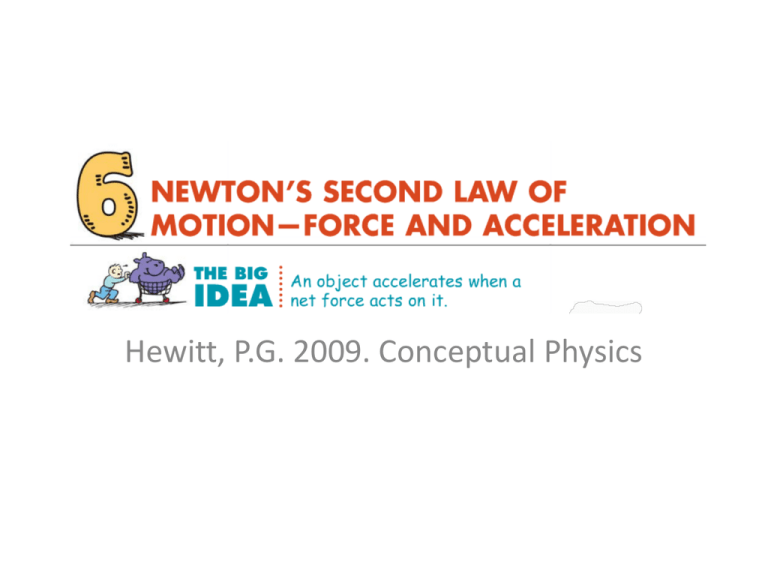
6 Newton’s Second Law of Motion Force and Acceleration Hewitt, P.G. 2009. Conceptual Physics Objectives • State the relationship between a and F and between a and m. (6.1 and 6.2) • State and explain Newton’s second law of motion. (6.3) • Describe the effect of friction on stationary and on moving objects. (6.4) • Distinguish between force and pressure. (6.5) • Explain why the acceleration of an object in free fall does NOT depend up on the mass of an object. (6.6) • Describe the effect of air resistance on a falling object. (6.7) Introduction • Recall the definition of acceleration accelerati on change in velocity time interval • Most objects in motion do not travel at a constant velocity, but instead accelerate. 6.1 Force Causes Acceleration If I kick the ball 2x harder, its acceleration is 2x greater. How about 3x? 0.5x? • Unbalanced forces acting on an object causes the object to accelerate. – Another way of saying net force (F) • An object’s acceleration is directly proportional to the net force acting on it. a F 6.2 Mass Resists Acceleration • For a constant net force, an increase in the mass will result in a decrease in the acceleration. If the rhino was 2x as massive, acceleration would be half as much? What about 3x bigger? 0.5x? a 1 m • The acceleration is inversely proportional to the mass. 6.3 Newton’s Second Law • Acceleration is directly proportional to the net force on the object, is in the same So what happens to acceleration if both the and net force and the direction of the netmass force, is inversely are doubled? If net force is doubled massobject. is proportional to the mass ofand the quadrupled? a F m • In equation form a F m Questions 1. A car has a mass of 1000 kg. What is the acceleration produced by a force of 2000 N? 2. If the force is 4000 N, what is the acceleration? 3. How much force, or thrust, must a 30 000 kg plane produce in achieve an acceleration of 1.5 m/s2? 4. What kind of motion does a constant force produce on an object of fixed mass? 6.4 Friction • Friction is a force that resists motion. – Acts when materials are in contact with each other. – Caused by irregularities on the surfaces of materials. – Magnitude of frictional force depends on the kind of materials in contact and how much they are pressed together. • Friction can occur in fluids (liquids or gases). • Air resistance is the friction that results when an object moves through the air. – Happens when the moving object has to push aside the fluid it is moving through. – Depends on the shape of the object and on the speed of the object. • More surface area in contact with fluid, more air resistance. • More speed, more air resistance. • Free-body diagrams show all the forces acting on an object. • Below, the free-body diagrams show that although an object has a force acting on it, the object can move at a constant velocity because of friction. Questions 1. Two forces act on a book resting on a table: its weight and the support force from the table. Does the force of friction act on it as well? 2. Suppose a jet cruises with a constant velocity when the trust from its engine is a constant 80 000 N. What is the acceleration of the jet? What is the force of air resistance acting on the jet? 6.5 Applying Force—Pressure • Pressure is the amount of force per unit area. – For a constant force, an increase in the area of contact will result in a decrease in pressure. Pressure Force area of applicatio n • Units for pressure: Pressure is measured in newtons per square-meter, or pascals (Pa). P F A Questions 1. In attempting to do the demonstration in Figure 6.7 on the previous slide, would it be wise to begin with a few nails and then work upward to more nails? Why or why not? 2. The massiveness of the cement block plays an important role in the demonstration. Which provides more safety, a less massive block or a more massive one? 6.6 Free Fall Explained • All freely falling objects fall with the same acceleration because the net force acting on the object is only its weight, and the ratio of weight to mass it the same for all objects. Question 1. If you were on the moon and dropped a hammer and a feather from the same elevation at the same time, would they strike the surface of the moon at the same instant? 6.7 Falling and Air Resistance • Air resistance is directly proportional to both the speed of the falling object AND the object’s frontal area. air resistance speed frontal area • The force due to air resistance reduces the net force acting on the falling object. • Terminal speed is the speed at which the acceleration of a falling object is zero because friction balances the weight. • Terminal velocity Question 1. If a heavy person and a light person open their parachutes together at the same altitude and each wears the same size parachute, who will reach the ground first?
